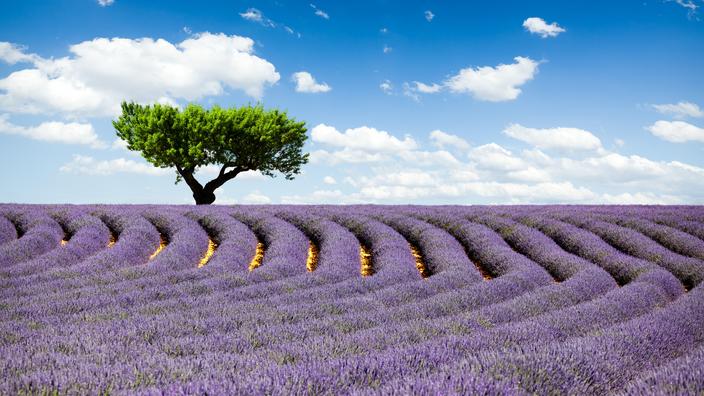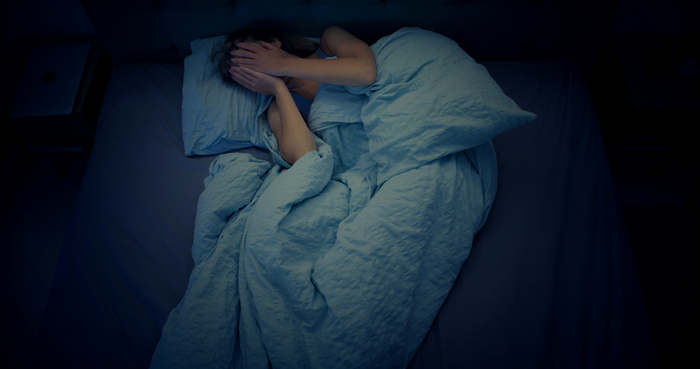For everyone, sleeping well is a necessity.
However,
sleep disturbances
are common and increase with age.
Men lack an average of an hour to an hour and a half of sleep per night, or one cycle.
To discover
This month in the garden: what to plant, sow or harvest in June?
June: what are the seasonal vegetables and fruits?
Frantic pace of life, stress, use of screens before going to bed… the causes are many and varied.
To promote falling asleep and avoid the consumption of hypnotics, herbal teas and food supplements may be sufficient.
As long as you adopt good hygiene and maintain a good balance of life.
Read the file: Sleep, a health issue to be taken seriously
Orange blossom
(Citrus vulgaris) - Family: rutaceae
Orange blossom has sedative and antispasmodic properties recognized since the dawn of time.
Scisetti Alfio / Adobe Stock
The scent of this small tree native to India and China, introduced in France at the time of the Crusades, immediately appeases.
To fight against
sleep disorders
, the white flowers of sour orange (bitter orange) have sedative and antispasmodic properties recognized since the dawn of time.
They generally flower in April, in the Mediterranean, in March, in India and in North Africa and make it possible to obtain the essential oil.
They are also used for the preparation of hydrosol with calming properties.
It contains flavonoids, aromatic molecules, vitamin C, carotene, essential oil, terpenols, bitter principles, terpenes and alcohol.
Read also: Mexican orange tree, ideal for scenting the hedge
Pillow mist
For 125 ml of liquid, mix in a bottle 70 ml of 90 ° alcohol and the essential oils (60 drops of lavender, 40 drops of tangerine, 20 drops of shell marjoram).
Add 50 ml of orange blossom hydrosol.
Leave to rest for 3 or 4 days.
White coffee
Mix a teaspoon of orange blossom water and a teaspoon of honey in a cup of boiling water.
Also read: How many hours of sleep do you need?
Linden blossom
(Tilia vulgaris) - Family: tiliaceae
Linden flowers contain an aromatic essence abundant in magnesium with sedative properties.
Martine A Eisenlohr / Adobe stock
Whether it is a small leaf linden or a large heart-shaped leaf, the flower has a very pleasant floral honey taste.
It is harvested from the end of May to the beginning of June and grows very easily along the avenues in town, in the forest and in the gardens.
It must also be picked up quickly because the petals fall quickly.
Rich in flavonoids, linden flowers contain an aromatic essence abundant in magnesium with sedative properties.
They soothe the nervous system, calm tension and are recommended in times of increased stress and mental fatigue.
Their effect on falling asleep has been proven since the dawn of time.
A natural calming without addiction!
To read also: Linden tree: how to correct a failed pruning?
Hot bath
To increase the beneficial effect of an infusion of linden flowers, a bath is totally relaxing before going to bed.
It is enough to add 200 g of decoction of linden flowers to 2 l of water.
Cooking
To make cakes and breads, prepare lime leaf flour from dried and crushed flowers.
Hops
(Humulus lupulus) - Family: cannabaceae
Hops belong to the cannabis family.
Václav Mach / Adobe Stock
Easy to find at the edge of the water, the hops are harvested in September, which gives the excuse for a nice walk.
From the cannabinaceae family, it grows in Europe, Asia and North America.
In France, it is mainly found in Alsace, where it is used for making beer.
In this region, the inhabitants also consume it in salads for its taste similar to young asparagus.
Its pale green, serrated leaves are reminiscent of the vine, and its cone-shaped flowers are typical.
The flavor, quite bitter, invites to mix it with other plants such as lavender, chamomile, lemon balm.
In the 12th century, Hildegarde de Bingen suggested consuming it for its action against melancholy.
Very effective, it acts against insomnia and you just need to put a small amount.
Never forget that hops belong to the cannabis family, so beware of activities requiring concentration after drinking a cup of infusion!
Herbal tea
Put 10 g in ¼ l of boiling water.
Let infuse 10 min.
Drink with or without sugar.
Mother tincture
Place 10 g of cones (female flowers) in 90 g of 90 ° alcohol.
Filter and store the liquid in a bottle.
At each use, take 2 to 4 g.
Lavender
(Lavandula) - Family: lamiaceae
It is enough to inhale lavender flowers to feel the benefits in case of stress, anxiety and sleep disorders.
Daylight Photo / stock.adobe.com
Its mauve or purple flowers distinguish it from a distance.
Bees love to land on its ears.
In summer, at harvest time, its colorful and fragrant fields delight locals and holidaymakers.
Very resistant, lavender grows easily in the scrubland, and up to 800 meters of altitude where it becomes rich in essential oils.
The Romans perfumed their baths with it.
In Provence, it was used to insulate houses and thus prevent parasites.
It was applied to viper bites to neutralize the venom.
But its properties go far beyond: antispasmodic, diuretic, sedative, etc.
It is enough to inhale it to feel the benefits in case of stress, anxiety and sleep disorders.
Read also: What is the difference between lavender and lavandin?
Pillow mist
Add to 30 ml of orange blossom hydrosol, 10 drops of true lavender essential oil, 10 drops of yellow mandarin essential oil, 10 drops of orange essential oil and 5 drops of essential oil. essential oil of Roman chamomile.
Fill a spray bottle, it's ready!
Infusion
5 g for 1 l of boiling water.
Infuse 10 minutes and drink 3 cups a day between meals.
Marjoram
(Origanum majorana) - Family: lamiaceae
Marjoram soothes and helps reduce the effects of stress.
Pixelmixel / Adobe stock
Marjoram, this plant with a scent similar to thyme, grows around the Mediterranean basin and has been cultivated in France since the 16th century.
Its small oval leaves are downy and its purple or light pink flowers appear in summer.
Marjoram is also known as oregano, from the Greek origanon (mountain and joy).
The etymology amarakos, draws its origin from the legend according to which a servant of the king of Cyprus, Amarakos, is transformed into marjoram after having committed a theft.
In ancient Greece, it brought peace of mind to graves, while the Egyptians used it to embalm their dead.
The Greeks concoct an ointment made from thyme, sage, basil and honey to relieve diseases of the nerves.
Since then, marjoram has been soothing and helping to reduce the effects of stress.
It acts directly on mild insomnia.
Herbal tea
Let 40 to 50 g of plant infuse in 1 l of boiling water for 10 minutes, filter and drink before going to bed.
Keep the leaves for warm applications in case of rheumatism, for example.
Oil
In a jar, macerate 100 g of marjoram in ½ liter of olive oil.
Place in a double boiler on the 3rd day and boil the water for one hour.
Let cool and fill a tightly sealed bottle.
Lemon balm
(Melissa officinalis) - Family: lamiaceae
Lemon balm leaves contain different active ingredients contributing to relaxation and serene sleep.
Nikolaydonetsk / Adobe stock
Lemon balm can be discovered at the bend of a wood during a walk, in the south of France, in Corsica and in Anjou.
The cut is made at the end of spring and in summer by collecting the leaves and flowering tops.
The virtues of lemon balm were discovered by Arab doctors before being recognized by French doctors in the 17th century to fight against nervous breakdown.
Charlemagne would have asked his subjects to grow it in their garden to benefit from its properties.
Its leaves contain various active ingredients contributing to relaxation and serene sleep.
The plant calms and prevents recurring nightmares and repeated insomnia.
Associated with valerian, passion flower or lavender, it becomes even more effective in relaxing the nervous system.
Lemon balm water
Macerate for 15 days in 1 l of brandy or alcohol at 80 °, 50 g of lemon balm, 5 g of cinnamon, 15 g of untreated lemon zest, 10 g of root angelica, 15 g coriander, 10 g cloves, 15 g nutmeg.
Filter and store in an airtight bottle.
To consume on a sugar, in a glass of water or a toddy.
Passionflower
(Passiflora incarnata) - Family: Passifloraceae
The active ingredients of passionflower, contained in its flowers and leaves, act directly on the main inhibitory neurotransmitter of the central nervous system.
Wingedbull / Adobe stock
With its huge and colorful flowers, passionflower, a perennial and climbing herb, native to South America, is harvested between July and September.
It is found today as far as Asia, North Africa and Southern Europe.
If the Aztecs already cultivated it for its sedative and anxiolytic properties, it was really discovered by Spanish missionaries in the 16th century.
They call it Passiflora incarnata (Passion flower) because of its shape, assimilated to the five wounds of the crucifixion.
The conquistadors appreciate its soothing virtues and its effects on sleep disorders.
Indeed, the active ingredients, contained in its flowers and leaves, act directly on the main inhibitory neurotransmitter of the central nervous system.
Passionflower is even effective for depressive states.
Read also: Is the fruit of passionflower edible?
Infusion
Pour boiling water over the plant and let infuse 5 to 10 minutes.
Note: limit its consumption in the event of urinary problems.
Mother tincture
Let the passionflower macerate in pure alcohol (twice the volume of the plant) for three weeks.
Filter and store the liquid in a bottle.
At each use, pour 30 drops in a glass of water.
Valerian
(Valeriana officinalis) - Family: caprifoliaceae
The antispasmodic virtues of valerian make it an ideal remedy to fight against insomnia and negative nocturnal thoughts.
behewa / Adobe stock
With its special smell, cats love it!
They can go crazy if they smell it in a sachet or jar.
Valerian, a common plant in France, grows in moist soil, near waterways.
Its small white flowers appear at the end of July and form a bouquet, but only the root is used.
In the 18th and 19th centuries, it treated hysteria, epilepsy and more generally nervous disorders.
Its antispasmodic properties make it an ideal remedy to fight against insomnia and negative nocturnal thoughts.
It is even nicknamed the vegetable valium!
Be careful not to consume it before driving, for example.
This vegetable calming is formidably effective!
Herbal tea
Put a tablespoon of cut roots in ¼ l of cold water.
Cover, bring to a boil 2 to 5 min.
Remove from heat and let steep under cover for 10 min.
Drink 30 minutes to 1 hour before bedtime.




/cloudfront-eu-central-1.images.arcpublishing.com/prisa/7GBYEZIDTZEK7NLSBDHWXQXBFY.jpg)



